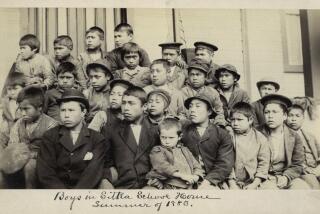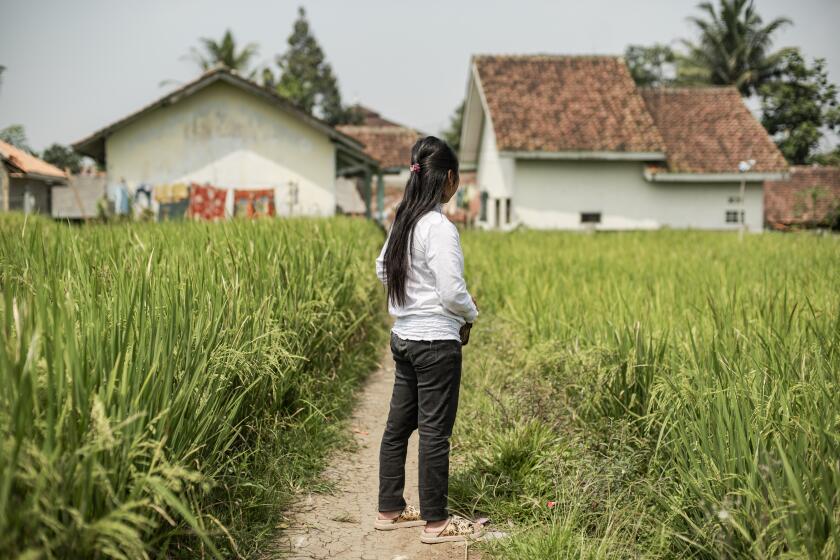For Indians, Trust Fund Case Can Right a Century of Wrongs
HEART BUTTE, Mont. â Josephine Spotted Bear Wildgun knows nothing of courtrooms.
She is 75, with a sixth-grade education. When a stranger strikes up a conversation, she giggles like a girl, flashing a gap-toothed grin, and burrows her chin in her chest.
She lives a simple life in a peaceful place, far from Washington, D.C., and the legal battle between Native Americans and the federal government over mismanagement of Indian trust accounts.
But what she does know is that she is a landowner and has little to show for it.
âSomebody else is getting rich on it,â she says.
A federal judge this month ordered a mediator to help negotiate the settling of 300,000 trust accounts worth more than $500 million. The decision came in a 1996 class-action lawsuit against the Interior Department and its Bureau of Indian Affairs.
The lawsuit, the largest class action ever brought by Indians, made headlines after the judge this year held Interior Secretary Bruce Babbitt and then-Treasury Secretary Robert Rubin in contempt for âegregious misconductâ in failing to hand over documents to the plaintiffs.
Beneath all the courtroom rhetoric lies a tragic tale of history, deceit and survival.
It is the story of people like Josephine Spotted Bear Wildgun, and places like Heart Butte.
A Solution to the âIndian Problemâ
On the southern edge of the Blackfeet Indian Reservation in northern Montana, a mountain shaped like a heart rises above golden plains where cattle and horses graze. It is the anchor of a community called Heart Butte.
Like so many other Indian communities across the United States, Heart Butte doesnât have much.
There are three churches, the Baptist, Methodist and Roman Catholic; a school, a senior citizens center, the health department, a post office and a volunteer fire department.
Its only grocery store and gas station closed years ago. Now the closest are a 30-minute drive across the reservation.
The only recent development, besides a new sanctuary for the Catholic church, is the row of federally subsidized houses that greets visitors on their way into town. They frame the road like a string of paper dolls, each the same bland image as the one before.
Welfare is the primary source of income for the 800 or so people who live here.
A block off the main road, around the corner from the subsidized housing, Josephine lives with her daughter-in-law and grandbaby in a three-bedroom plywood house the color of dirt. Her son visits when heâs not out of town looking for work.
Josephine lives on $374 a month in Supplemental Security Income and whatever money her son can send home. When her husband died five years ago, she had to borrow $500 to pay for the funeral.
âWhen I get money,â she explains, âIâve got my phone, my lights and gas. Those three I pay for.â
Other things, even groceries, are harder to afford.
Itâs difficult to conceive that this woman who struggles to buy food owns an interest in 8,718 acres of land, some leased for grazing, most for oil and gas exploration. A computer printout of all her holdings unfurls to almost 6 feet in length, taller than Josephine herself.
For this she also receives income. The checks arrive sporadically, every four to six months. Every once in a while theyâre as high as $200 or $300. More often theyâre for much less: $36.75 in September 1998; another, in July 1998, for $2.82.
âIâm sure thereâs a lot of money she should be getting,â her daughter-in-law, Diana, says as she tickles her baby girl on the floor of the cramped living room. âI think theyâre cheating her really big.â
âTheyâ are the Interior Department and the Bureau of Indian Affairs, which for more than 100 years have managed Indian trust accounts consisting of lease revenue, court settlements and royalties from the sale of petroleum, timber and other resources off 11 million acres of land.
In addition to the 300,000 individual Indian accounts that are part of the lawsuit, the government oversees 1,500 accounts worth more than $2.5 billion for 338 tribes.
The trust accounts date from 1887, when Congress carved up Indian reservations and distributed the land to tribal members in 160-, 80- or 40-acre parcels. Leftover land was declared surplus and sold to non-Indians, resulting in the eventual loss of 90 million acres.
The intent of the allotment law, known as the Dawes Act, was to assimilate Indians into white society by dissolving tribalism and forcing them to become independent farmers, while at the same time opening up large tracts of reservation land to white farmers.
âAt the heart of it was the idea . . . that once the Indians became citizens and no longer dependent on the government, then the so-called âIndian problemâ would disappear,â says L.G. Moses, professor of American Indian history at Oklahoma State University. âThe only real result you got out of the Dawes Act was the loss of land accompanied by an assault on Indian cultural values.â
By the early 1900s, the Dawes Act had proved a failure. Indiansâ land sat idle, while their white neighbors longed to use the acreage. By 1910 the government began leasing Indian property to white farmers for grazing. Oil exploration began soon after, and so did the problems.
There was no accounts receivable system to determine whether Indians were being paid, and when Indian landowners died, there generally were no wills. That meant the land was divided among hundreds or thousands of heirs, creating a record-keeping nightmare.
Government Admits Mismanagement
Some land was held in probate for years; some heirs were simply never found.
Because of a lack of oversight, many Indians suspect oil companies and others have underreported what theyâve taken from the land and gotten away with it for years.
âIn any Indian community, itâs just been something that we grew up with, our parents questioning and wondering why they were not getting paid,â says Elouise Cobell, a Blackfeet member and the lead plaintiff in the class-action lawsuit.
The problems gained little notice until the 1980s, when people like Cobell began complaining to Congress and numerous audits documented the severity of the problem: Records had been lost or ruined; auditors couldnât locate 50,000 account holders whose trusts totaled almost $50 million. One account with no name was worth $1 million.
The government has long admitted the trust funds are in disarray, and recently installed a $60-million computer system to manage the accounts better.
Testifying in court in July, Babbitt said the program was âheading toward a safe harbor of complianceâ and vowed to have a better accounting system in place when he leaves office in January 2001.
Indians want a complete overhaul of the system and contend the government owes account holders at least $10 billion misplaced because of poor record-keeping.
âWhat we hear all the time is, âOh, most of these accounts only have $25 or âxâ amount,â â Cobell says. âWhat does $25 mean to a family? Maybe sheâs able to cook a meal and share that with her family for once. That $25 stretches out to be much more than 25 bucks.â
âItâs like I have an inheritance that I didnât even know about,â says the Rev. Dan Powers of St. Anneâs Catholic Church in Heart Butte, who speculates that almost every resident in his community owns an interest in the 1.5-million-acre reservation. Many of his church members receive trust money but remain in debt.
âSome of the people get lease money twice a year,â he says. âFamily members sit around waiting to be fed by that.â
The Bureau of Indian Affairs estimates there are 7,700 Blackfeet with trust accounts, although Cobell says the number is closer to all the 14,700 enrolled tribal members, of whom about two-thirds live on the reservation amid a 70% unemployment rate.
Here, where the average monthly income for a family of four is just $600, restitution could provide a fresh start for many, Blackfeet leaders say. It could also mean attaining what the government tried to manufacture so long ago: economic independence.
âWe could start buying our land back . . . [and] work the land ourselves,â says Blackfeet Treasurer Joe Gervais. âIf we do it ourselves, we prove that we can succeed. We take control of our own destiny.â
More to Read
Sign up for Essential California
The most important California stories and recommendations in your inbox every morning.
You may occasionally receive promotional content from the Los Angeles Times.









